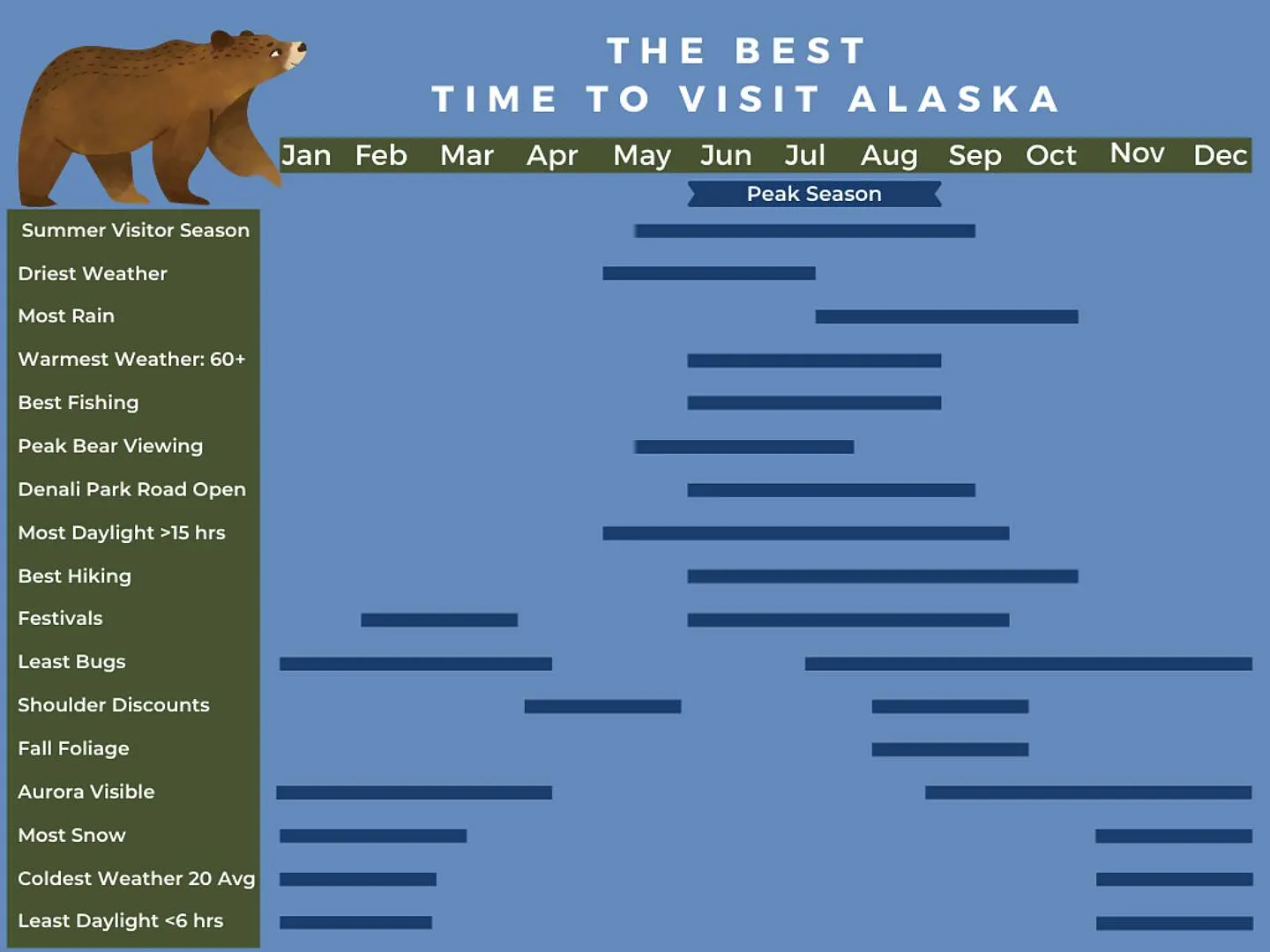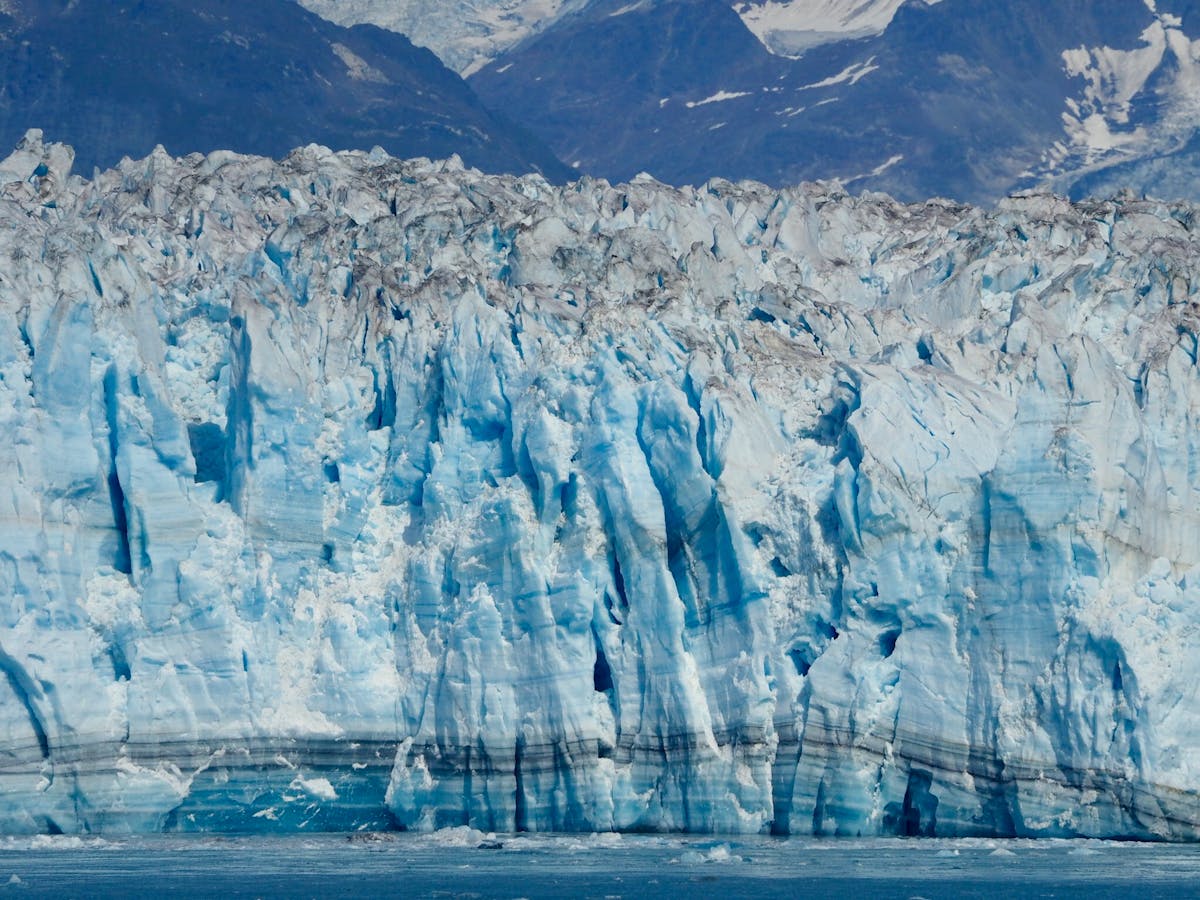Deciding the Best Time To Travel To Alaska is crucial for an unforgettable journey to the Last Frontier. While every season offers unique beauty and experiences, the peak summer months shine brightest for many visitors. From endless daylight perfect for exploring to unparalleled wildlife viewing opportunities, understanding Alaska’s distinct seasons is key to planning your ideal trip. Let’s explore the nuances of Alaska’s climate and attractions throughout the year to help you pinpoint your perfect travel window.
Summer, spanning roughly from May to September, is widely considered the Best Time To Travel To Alaska. During this period, temperatures are mild, typically ranging from the 60s to low 70s Fahrenheit (15-25°C). The landscape bursts into vibrant life with blooming flowers and lush greenery. Rivers swell with meltwater, and wildlife is incredibly active. The sheer amount of daylight, from 16 to 24 hours depending on latitude, allows for extended hours of adventure under the famous “Midnight Sun.”
Exploring Alaska’s Summer Seasons: When is Peak?
While the entire May to September window is popular, the absolute peak season is often cited as mid-June to mid-July. This month offers the warmest temperatures, often the driest weather in many areas, and maximum daylight hours. It’s when many iconic Alaskan experiences, from fishing charters to hiking mountain trails, are in full swing. However, this popularity also means higher prices and larger crowds.
May & Early June: Spring Awakenings
Traveling in May or early June can also be an excellent choice and part of the Best Time To Travel To Alaska for those seeking fewer crowds and slightly lower prices. Temperatures are cooler, typically 5-10 degrees Fahrenheit lower than mid-summer, but still pleasant. May is notably the driest month of the summer season, offering a higher chance of clear skies. Wildlife like moose and migratory birds are abundant, and the landscape is just beginning to green up. Snow is usually melted from lower elevation trails by early June.
 When is the best time to visit alaska calendar infographic
When is the best time to visit alaska calendar infographic
July & August: Heart of Summer Adventures
July and August represent the core of Alaskan summer. This period boasts the warmest weather and the height of many activities. It’s prime time for salmon runs, making fishing exceptional. Bear viewing, particularly brown bears congregating at salmon streams, is phenomenal in July. While these months can see more rain than May, the long daylight hours more than compensate, allowing travelers to pack their days with adventures like hiking, kayaking, and flightseeing.
Late August & September: Fall Colors and Northern Lights
For many, late August and September also qualify as the Best Time To Travel To Alaska, offering a unique blend of summer’s lingering warmth and the first hints of fall. The landscape transforms into stunning hues of gold, red, and orange, particularly vibrant in tundra regions. As nights begin to lengthen, the chances of seeing the magical Northern Lights (Aurora Borealis) increase significantly, especially from mid-August onwards. While temperatures cool and rain chances rise compared to mid-summer, the scenery and potential for aurora make this a highly rewarding time to visit.

Alaska’s Wildlife Viewing Seasons
Wildlife viewing is a major draw for travelers deciding the Best Time To Travel To Alaska. The summer months, May through September, are generally the most active for seeing a wide variety of animals. Bear viewing peaks in July when salmon are running, but fly-in viewing starts as early as May. Moose are year-round residents, often seen near urban areas. Whale watching opportunities vary: gray whales migrate north in March/April, humpbacks are common from May to September, and orcas can be spotted year-round.
What to Eat in Fort Worth – A Culinary Deep Dive
Discover the Top Restaurants in Denver – A Culinary Journey
Discover Where to Visit in Las Vegas
Fishing is another popular activity that is excellent throughout the summer. Different species of salmon run at various times, ensuring good fishing opportunities from June through September. Whether you’re interested in fly fishing for trout or deep-sea fishing for halibut, summer is the time to cast your line.
Navigating Weather, Daylight, and Insects
Understanding the conditions is key when considering the Best Time To Travel To Alaska. Daylight hours are longest around the summer solstice on June 21st, offering nearly 24 hours of usable light in some northern regions. Even in Anchorage, you’ll have light well past 10 pm for months. This means more time for activities!

Temperatures during the recommended summer season (May-September) generally range from 60-80°F during the day and cool off to the 40s-50s°F at night. Layering clothing is essential. Rain is possible throughout the summer, increasing towards September, so packing waterproof gear is advisable.
One practical consideration for summer travel is mosquitoes and other biting insects. These are most prevalent from early June to early August. While they can be managed with repellent and head nets, travelers particularly sensitive to bugs might find late May or late August/September more comfortable.
Northern Lights and Shoulder Seasons
While summer is the Best Time To Travel To Alaska for many activities and comfortable weather, it’s not the prime time for viewing the Northern Lights due to the lack of darkness. If seeing the aurora is your priority, you’ll need to visit when the nights are dark enough, typically from late August through April. A trip combining late summer activities with aurora potential is possible from mid-August to mid-September.

Spring (March-April) offers increasing daylight, possibilities for seeing the start of wildlife migrations (like gray whales), and still chances for northern lights early in the season. Fall (October-November) brings colder temperatures but striking scenery and excellent aurora viewing potential as darkness returns. Winter (December-February) is ideal for snow sports, dog sledding, ice sculpting, and consistent aurora viewing, but temperatures are much colder and daylight hours are minimal.
What About the Rest of the Year?
While summer is often highlighted as the Best Time To Travel To Alaska, the other seasons offer unique experiences for specific interests. Winter is a wonderland for those seeking snow-covered landscapes, dog sledding adventures, ice fishing, and consistent opportunities to witness the Northern Lights dance across the dark sky. Cities like Fairbanks are known for their excellent aurora viewing conditions in winter.
Spring in Alaska, roughly March and April, is a transitional period. Days grow longer rapidly, snow begins to melt at lower elevations, and migratory birds start to return. It’s a great time for spring skiing or experiencing events like the Iditarod Trail Sled Dog Race. Opportunities for aurora viewing still exist earlier in this period.
Fall, specifically October and November, sees the vibrant autumn colors fade into a more stark, quiet beauty. Temperatures drop, and snowfall becomes more likely. This is a time for quieter travel, enjoying crisp air, and continuing to hunt for the Northern Lights before the deep cold of winter sets in. Each season in Alaska has its own rhythm and appeal, offering different ways to connect with this vast and wild landscape.
Frequently Asked Questions About Timing Your Alaska Trip
Planning a trip to Alaska brings up many questions, especially regarding the ideal time to visit. Here are some frequently asked questions:
When is the cheapest time to go to Alaska?
Generally, the shoulder seasons (May, September) and the off-season (October-April) offer lower prices for flights and accommodations compared to the peak summer months (June-August).
When is the warmest month in Alaska?
July is typically the warmest month across most of Alaska, with average high temperatures often reaching into the 60s and low 70s Fahrenheit in populated areas.
When is the best time to see whales in Alaska?
Humpback whales are commonly seen from May to September. Gray whales migrate north in March and April. Orcas can be seen year-round, though sightings can be less predictable.
Can you see the Northern Lights in summer in Alaska?
Due to the extensive daylight (Midnight Sun), it is generally not dark enough to see the Northern Lights during the core summer months (June, July). Viewing becomes possible again from mid-August as nights lengthen.
When are the fewest mosquitoes in Alaska?
Mosquitoes are most active from early June to early August. Visiting in May or late August/September usually means fewer bugs.
Conclusion: Finding Your Perfect Alaska Timing
Ultimately, the Best Time To Travel To Alaska depends on your personal interests and priorities. If you dream of warm weather, maximum daylight, peak wildlife activity, and accessing the widest range of tours and activities, aim for June or July. If you prefer fewer crowds, lower prices, and don’t mind slightly cooler temperatures or higher rain chances, May, August, or September could be perfect. If seeing the Northern Lights is your main goal, plan your visit between late August and April. No matter when you choose to go, Alaska promises a unique and awe-inspiring adventure that connects you deeply with nature and its incredible power.
